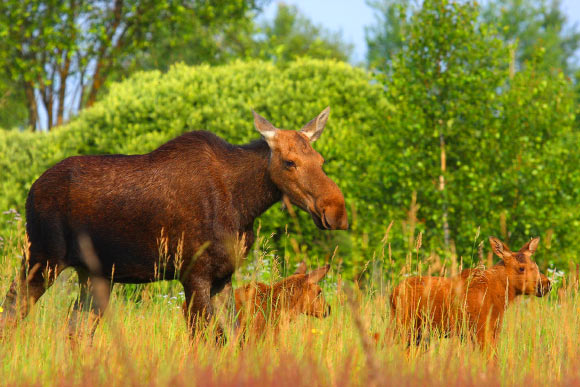In 1986, after a catastrophic nuclear accident at the Chernobyl Nuclear Power Plant in the Soviet Union released radioactive particles into the environment, thousands of people left the area, never to return. Now, an international group of researchers has found that the site (known as the Chernobyl Exclusion Zone) looks less like a disaster zone and more like a nature preserve, teeming with wolves, moose, roe deer, red deer, and wild boar.

A family of moose roams free in the Chernobyl Exclusion Zone. Image credit: Valeriy Yurko / Polesie State Radioecological Reserve.
Previous studies in the 1,621-square-mile Chernobyl Exclusion Zone showed evidence of major radiation effects and significantly reduced populations of wildlife.
For the first time since the Chernobyl accident, scientists have long-term census data that reveal thriving wildlife populations in the zone.
“Our data are a testament to the resiliency of wildlife when freed from direct human pressures such as habitat loss, fragmentation and persecution. The multi-year data clearly show that a multitude of wildlife species are abundant throughout the zone, regardless of the level of radiation contamination,” said Dr Jim Beasley from the University of Georgia, a co-author of a paper published in the journal Current Biology.
The study results show that the relative abundance of moose, roe deer, red deer, and wild boar within the Chernobyl Exclusion Zone are now similar to those in four uncontaminated nature reserves in the region.
The census data on wolves in the area indicate they are 7 times greater in number than those living in the nearby reserves.
“This doesn’t mean radiation is good for wildlife, just that the effects of human habitation, including hunting, farming and forestry, are a lot worse,” added senior author Prof. Jim Smith from the University of Portsmouth, UK.
Helicopter survey data also reveal rising trends in the abundance of moose, roe deer, and wild boar from one to ten years after the accident.
A dip in the wild boar population at one point was traced to a disease outbreak unrelated to radiation exposure.
“These results demonstrate for the first time that, regardless of potential radiation effects on individual animals, the Chernobyl Exclusion Zone supports an abundant mammal community after nearly three decades of chronic radiation exposure,” the scientists said.
“These increases came at a time when moose and wild boar populations were declining in other parts of the former Soviet Union.”
“I’ve been working, studying and taking photos of the wonderful wildlife in the Chernobyl area for over 20 years, and I am very pleased our work is reaching an international scientific audience,” said Dr Tatiana Deryabina, a wildlife ecologist at the Polesie State Radioecological Reserve in Belarus and the study’s lead author.
_____
T.G. Deryabina et al. 2015. Long-term census data reveal abundant wildlife populations at Chernobyl. Current Biology, vol. 25, no. 19, pp.R824-R826; doi: 10.1016/j.cub.2015.08.017







